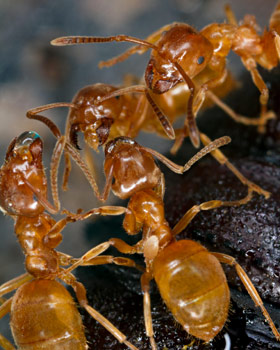Turfgrass Ant and Cornfield Ant, Lasius spp.
Other turf ants may include: little black ant, pavement ant, and larger yellow ant.

David Cappaert, Michigan State University, Bugwood.org.
IPM Steps to Reduce Ants
1. Sample for Pest
Confirm the presence of ants before you treat.
Where to find it while inspecting: Look for small active ant hills in patchy areas of turf.
2. Proper ID
Are they ants?
Size and Appearance: Generally 1/8" long (various shades of light to dark brown).
3. Learn the Pest Biology
What is the life cycle of ants?
Life Cycle: Overwintering colonies and queens will resume activity in spring. Mated queens lay new eggs in spring which hatch into workers; workers take over the role of raising young while the queen continues to lay eggs throughout the season. In some circumstances females and males leave the colony in both spring and fall, but more often mating in fall.
Preferred Food Sources: Turfgrass ants feed on dead insects, earthworms and similar organic matter and are an integral part of soil culture.
Preferred Habitat: Prefers undisturbed soil in turfgrass, but manages to exist on athletic fields and golf courses.
4. Determine Threshold
How many ants are too many?
Threshold: A few mounds in turf is not really a concern, and as ants are an important part of the environment you may want to leave them be. A few mounds on sports fields should be addressed as they may create unsafe footing and will reduce the vigor of turf.
5. Choose Tactics
Creating a healthy soil condition and understanding turfgrass’s needs is the first step in reducing turf pests. What can I do to treat, reduce, or prevent ants?
Best Management Practices: There is little to do to persuade ants to move their colony. Death of the queen, early in the season, will alter the colony significantly. Frequent disturbance may be enough to keep the colony small or encourage them to move.
Treatment Methods: Spot treatments of bait at the site are one treatment option and are effective with time (and dependent on weather—don’t irrigate until the next day). These are generally preferred over insecticide treatments as they are less likely to reach all colony members and must be retreated. All pesticide applications must be done by a certified applicator.
6. Evaluate
Was the tactic successful? Record the date pests were first noted, and the tactic you used, and its success. Use one of our RECORD KEEPING tools.
For More Information:
Rutgers Cooperative Extension Fact Sheet: Ant Management in Turfgrass
Remember:
When a pesticide application is necessary, all necessary and required precautions are taken to minimize risk to people and the environment and to minimize risk of pesticide resistance or pest resurgence. Pesticide use in your school may be prohibited or regulated by local policies or state and federal regulations. Risk reduction methods can include, but are not limited to, spot-treatment, the use of gel or paste bait formulations placed in inaccessible locations, injection into a crack or crevice, and other methods that reduce potential exposure.